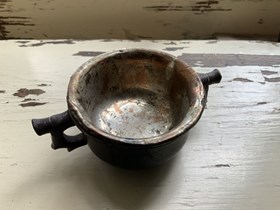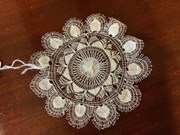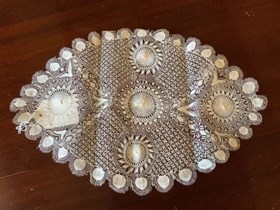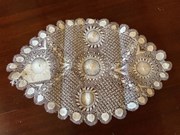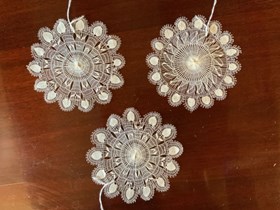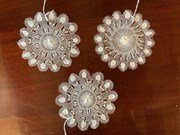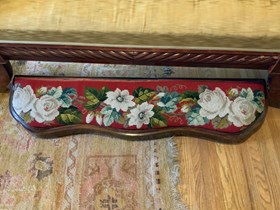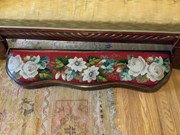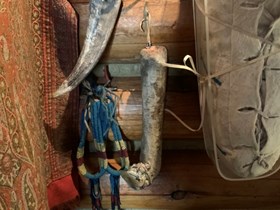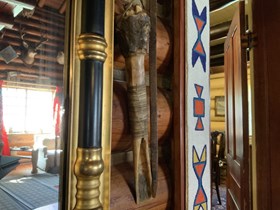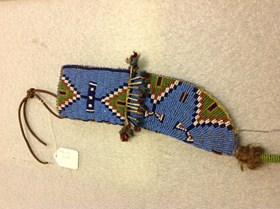Narrow Results By
- Date
- 1825 – 1875
- Material
- metal, silver; metal, copper; wood
- Catalogue Number
- 104.20.0477
- Description
- A round wooden cup with two carved angular handles. The cup has a silver plated copper lining. There is an illegible sticker remnant on the base.
1 image
- Title
- Cup
- Date
- 1825 – 1875
- Material
- metal, silver; metal, copper; wood
- Dimensions
- 4.0 x 11.0 cm
- Description
- A round wooden cup with two carved angular handles. The cup has a silver plated copper lining. There is an illegible sticker remnant on the base.
- Subject
- households
- crafts
- woodwork
- Credit
- Gift of Pearl Evelyn Moore, Banff, 1979
- Catalogue Number
- 104.20.0477
Images
This material is presented as originally created; it may contain outdated cultural descriptions and
potentially offensive content.
Read more.
- Date
- 1820 – 1850
- Material
- fibre, cotton
- Catalogue Number
- 102.04.0027
- Description
- One extremely delicate guipure lace doily. Guipure is a lace in which the patterns are held together by connecting threads rather than attached to mesh or net ground, as in filet lace. A delicate starburst centre is ringed by nine triangles and twelve petal shapes around the border.
1 image
- Title
- Doily
- Date
- 1820 – 1850
- Material
- fibre, cotton
- Dimensions
- 13.5 x 13.5 cm
- Description
- One extremely delicate guipure lace doily. Guipure is a lace in which the patterns are held together by connecting threads rather than attached to mesh or net ground, as in filet lace. A delicate starburst centre is ringed by nine triangles and twelve petal shapes around the border.
- Subject
- households
- decorative
- crafts
- needlework
- Credit
- Gift of Pearl Evelyn Moore, Banff, 1979
- Catalogue Number
- 102.04.0027
Images
This material is presented as originally created; it may contain outdated cultural descriptions and
potentially offensive content.
Read more.
- Date
- 1820 – 1850
- Material
- fibre, cotton
- Catalogue Number
- 102.04.0029
- Description
- One extremely delicate guipure lace doily. Guipure is a lace in which the patterns are held in place by connecting threads, rather than attached to mesh or net ground, as in filet lace. This doily is elliptical in shape with a petal shapes as a border. The interior design features a central circ…
1 image
- Title
- Doily
- Date
- 1820 – 1850
- Material
- fibre, cotton
- Dimensions
- 21.5 x 33.5 cm
- Description
- One extremely delicate guipure lace doily. Guipure is a lace in which the patterns are held in place by connecting threads, rather than attached to mesh or net ground, as in filet lace. This doily is elliptical in shape with a petal shapes as a border. The interior design features a central circle with four circles spaced around the edge of the piece.
- Subject
- households
- decorative
- crafts
- needlework
- Credit
- Gift of Pearl Evelyn Moore, Banff, 1979
- Catalogue Number
- 102.04.0029
Images
This material is presented as originally created; it may contain outdated cultural descriptions and
potentially offensive content.
Read more.
- Date
- 1820 – 1850
- Material
- cotton
- Catalogue Number
- 102.04.0028
- Description
- Three extremely delicate guipure lace doilies. Guipure is a lace in which the patterns are held in place by connecting threads rather than attached to mesh or net ground. 102.04.0028a is slightly different in design from the other two doilies. Each has a petal shape border with a starburst centre.
1 image
- Title
- Doily Set
- Date
- 1820 – 1850
- Material
- cotton
- Dimensions
- 14.0 x 14.0 cm
- Description
- Three extremely delicate guipure lace doilies. Guipure is a lace in which the patterns are held in place by connecting threads rather than attached to mesh or net ground. 102.04.0028a is slightly different in design from the other two doilies. Each has a petal shape border with a starburst centre.
- Subject
- households
- decorative
- crafts
- needlework
- Credit
- Gift of Pearl Evelyn Moore, Banff, 1979
- Catalogue Number
- 102.04.0028
Images
This material is presented as originally created; it may contain outdated cultural descriptions and
potentially offensive content.
Read more.
- Date
- 1821 – 1821
- Material
- glass
- Catalogue Number
- 102.04.0100
- Description
- A handblown glass vase with a plain base flaring to a wide rim. The punty mark is visible on the bottom. The vase is etched on the outside with a floral design around the monogram “WEC 1821”.
1 image
- Title
- Flower Vase
- Date
- 1821 – 1821
- Material
- glass
- Dimensions
- 15.0 x 12.2 x 12.2 cm
- Description
- A handblown glass vase with a plain base flaring to a wide rim. The punty mark is visible on the bottom. The vase is etched on the outside with a floral design around the monogram “WEC 1821”.
- Subject
- households
- decorative
- crafts
- Credit
- Gift of Pearl Evelyn Moore, Banff, 1979
- Catalogue Number
- 102.04.0100
Images
This material is presented as originally created; it may contain outdated cultural descriptions and
potentially offensive content.
Read more.
- Date
- 1870 – 1890
- Material
- wood, walnut; metal, brass; glass
- Catalogue Number
- 104.20.0470
- Description
- A shaped oval stand of walnut with a beaded floral pattern (black, white, grey, amber) on a linen pad (faded rose).
1 image
- Title
- Footstool
- Date
- 1870 – 1890
- Material
- wood, walnut; metal, brass; glass
- Dimensions
- 5.6 x 27.5 x 54.0 cm
- Description
- A shaped oval stand of walnut with a beaded floral pattern (black, white, grey, amber) on a linen pad (faded rose).
- Subject
- households
- decorative
- crafts
- needlework
- beadwork
- flowers
- Credit
- Gift of Pearl Evelyn Moore, Banff, 1979
- Catalogue Number
- 104.20.0470
Images
This material is presented as originally created; it may contain outdated cultural descriptions and
potentially offensive content.
Read more.
Footstool Stool
https://archives.whyte.org/en/permalink/artifact102.03.0034
- Date
- 1870 – 1900
- Material
- wood; hair, sheep; fibre
- Catalogue Number
- 102.03.0034
- Description
- Long footrest, the length of a standard sofa, that sits directly on the floor (it has no legs). One side arcs from the corners of the other, straight, edge and is slighly scalloped. The piece is covered with walnut burl veneer. The centre of the footrest features a large guage needlepoint design…
1 image
- Title
- Footstool Stool
- Date
- 1870 – 1900
- Material
- wood; hair, sheep; fibre
- Dimensions
- 13.5 x 30.0 x 122.0 cm
- Description
- Long footrest, the length of a standard sofa, that sits directly on the floor (it has no legs). One side arcs from the corners of the other, straight, edge and is slighly scalloped. The piece is covered with walnut burl veneer. The centre of the footrest features a large guage needlepoint design worked in wool on satin upholstery. The needlepoint is a floral design with a red background, white flowers, and green and brown leaves.
- Subject
- households
- furniture
- crafts
- needlepoint
- Credit
- Gift of Pearl Evelyn Moore, Banff, 1979
- Catalogue Number
- 102.03.0034
Images
This material is presented as originally created; it may contain outdated cultural descriptions and
potentially offensive content.
Read more.
- Date
- 1875 – 1920
- Material
- bone, elk; fibre; metal, steel
- Catalogue Number
- 104.24.0001
- Description
- A hide scraper made from the leg bone of an elk, and carved to form a long handle which fits the hand well. There is a short right angle carved at the bottom and split horizontally to hold a rounded steel blade that is sharpened at the edge. The bone is notched and tied firmly with a strip of cot…
1 image
- Title
- Hide Scraper
- Date
- 1875 – 1920
- Material
- bone, elk; fibre; metal, steel
- Dimensions
- 24.0 x 5.5 x 8.0 cm
- Description
- A hide scraper made from the leg bone of an elk, and carved to form a long handle which fits the hand well. There is a short right angle carved at the bottom and split horizontally to hold a rounded steel blade that is sharpened at the edge. The bone is notched and tied firmly with a strip of cotton fabric to secure the blade. A shiny metal hook is attached at the top along with a short loop of thong for hanging.
- Credit
- Gift of Pearl Evelyn Moore, Banff, 1979
- Catalogue Number
- 104.24.0001
Images
This material is presented as originally created; it may contain outdated cultural descriptions and
potentially offensive content.
Read more.
- Date
- 1875 – 1920
- Material
- bone; skin
- Catalogue Number
- 104.24.0002
- Description
- A hide scraper made from the leg bone of a deer or elk, from just below the knee, and carved into a squared shape. The scraper is hollowed and one half of its length is cut away leaving a flattened sharpened serrated end. The animal’s hide is still on the knee joint at the top and there is a han…
1 image
- Title
- Hide Scraper
- Date
- 1875 – 1920
- Material
- bone; skin
- Dimensions
- 38.0 x 6.0 x 6.3 cm
- Description
- A hide scraper made from the leg bone of a deer or elk, from just below the knee, and carved into a squared shape. The scraper is hollowed and one half of its length is cut away leaving a flattened sharpened serrated end. The animal’s hide is still on the knee joint at the top and there is a hanging thong threaded through a drilled hole at the knee. The bone is tightly wrapped with strips of rawhide (or sinew?) one third of its length to hold the two pieces together where the bone was split.
- Subject
- households
- Indigenous
- Stoney
- animals
- elk
- deer
- crafts
- carving
- Credit
- Gift of Pearl Evelyn Moore, Banff, 1979
- Catalogue Number
- 104.24.0002
Images
This material is presented as originally created; it may contain outdated cultural descriptions and
potentially offensive content.
Read more.
- Date
- 1870 – 1890
- Material
- skin; metal; hair, buffalo; glass; feather
- Catalogue Number
- 104.10.0008
- Description
- A simply shaped sheath for a knife with a leather thong for hanging the sheath from a belt. Both sides of the case are completely beaded with a light blue background and four pyramidal shapes in dark blue, white, red, green and orange. There is a band of tin cones, with coloured feathers at the…
1 image
- Title
- Knife Sheath
- Date
- 1870 – 1890
- Material
- skin; metal; hair, buffalo; glass; feather
- Dimensions
- 26.0 cm
- Description
- A simply shaped sheath for a knife with a leather thong for hanging the sheath from a belt. Both sides of the case are completely beaded with a light blue background and four pyramidal shapes in dark blue, white, red, green and orange. There is a band of tin cones, with coloured feathers at the end of each cone, that hangs around the middle of the sheath. A strip of blue and green beadwork, that is wrapped with sections of bison hide, hangs from the bottom point of the sheath.
- Credit
- Gift of Pearl Evelyn Moore, Banff, 1979
- Catalogue Number
- 104.10.0008
Images
This material is presented as originally created; it may contain outdated cultural descriptions and
potentially offensive content.
Read more.

